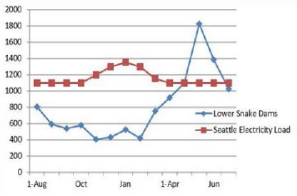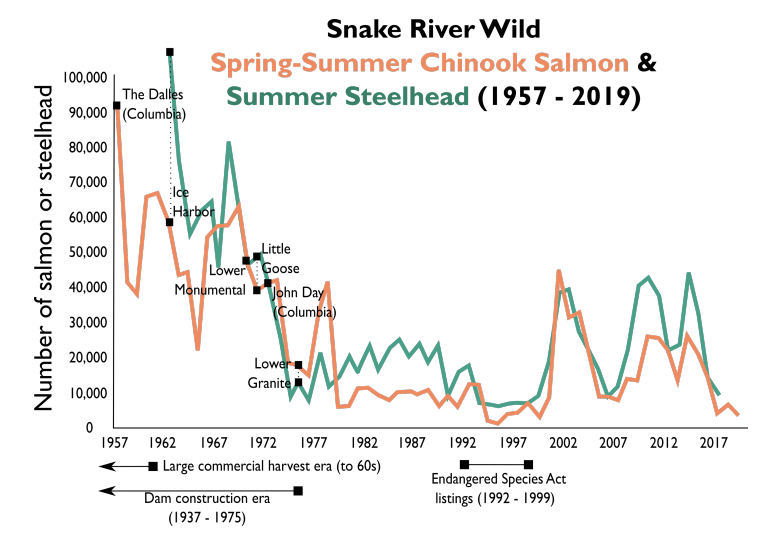

By Tamsin Fleming, Advocacy and Organizing Intern
March 17, 2021
How will removing the lower Snake River dams improve Columbia River fishing opportunities?
At one point, 50% of salmon returning to the Columbia River Basin spawned in the Snake River or its tributaries. Today, only 1% of these salmon return to their spawning grounds as adults to reproduce. Each interaction a juvenile salmon has with a dam reduces their chance of returning to the Columbia River as an adult by 10%. Snake River salmon have to pass eight dams during migration: four on the lower Snake River and four on the mainstem Columbia River, bringing their chance of returning as adults to just 20%. Removing the lower Snake River dams will remove half of the major obstacles blocking fish migration to and from their spawning grounds.
Current Snake River salmon returns are not sufficient to sustain the population. Snake River summer Chinook returns are around 1.27%, meaning that for every 100 salmon spawned, just over one returns as an adult to spawn another generation. Returns to the John Day River are at 4.21% by comparison, with salmon runs passing through 4 dams rather than 8.
Restoring a free-flowing lower Snake River will reduce heat pollution as well. Last year, the EPA identified the Snake River dams as the primary reason the mainstem Columbia River exceeds the 68 degree temperature threshold for salmon and steelhead all summer. Removing the four dams would help ensure river temperatures stay within livable conditions for these coldwater species. Draining the 140 miles of heat-trapping reservoirs and restoring plants along the river banks will cool the water, provide shade, and help protect fish from predators, benefits we’ve seen first-hand at dam removal sites like the Elwha River.
If these four massive barriers are removed, salmon and steelhead will have lower migration mortality rates, which will in turn lead to greater reproductive success, putting our wild runs on a trajectory for growth. Salmon returns are projected to more than double.
Hatchery production, bag limits, and quotas are determined by wild return numbers, and dramatically increasing wild returns with river restoration would result in greater harvest, longer seasons, and better catch rates that would improve fishing opportunities substantially.
Representative Simpson has included $700 million in his comprehensive proposal for a Columbia Basin Fund to fund fish passage through the upper basin, which would improve fishing opportunities throughout the Columbia River Basin.
Why should we remove the lower Snake River dams when sea lion predation and ocean conditions contribute to mortality?
Salmon face multiple threats during their arduous migration, including sea lion predation and variable ocean conditions. Sea lions are a natural source of salmon mortality, but their behavior has changed substantially in response to dams. As adult fish gather in front of fish ladders, sea lions have learned to take advantage of this easy source of prey. They have adapted to swim further inland and stay for longer periods to prey on vulnerable fish. The increasing number of sea lions just below the dams kill roughly 5,000 salmon from January to June each year.
Like sea lion predation, ocean conditions also impact mortality. Ocean conditions vary from year to year, but they typically alternate between 3-4 year warmer or cooler trends. When ocean conditions are good, cold water is being driven down from the north and the upwelling pushes nutrients from the ocean floor toward the coast. This is largely impacted by climatic factors and we don’t currently have management strategies to ensure ocean conditions are good for salmon.
How important are the lower Snake River dams for regional energy production?
Some argue that the four lower Snake River dams can produce enough power to supply a major city, but the fact is that the dams are not a significant source of our day-to-day regional power supply. Because they are run-of-the-river dams, they generate most of their power during spring runoff and winter rains, when regional power needs are the lowest. In the summer, when energy needs are highest, the four lower Snake River dams rarely produce even two thirds of their power capacity.
The four lower Snake River dams produce far less electricity than the 9,074,062 MWh that Seattle consumes each year. As you can see in the graph below, the four Snake River dams only produced enough electricity to power Seattle two months out of the year, on average, between 2010 and 2019.

This graph represents the aMW generated by the four lower Snake River dams monthly, compared to the monthly Seattle electricity load.
Further, while the mainstem Columbia River dams produce a significant amount of cost effective power for the region, the Snake River dams do not. They hurt salmon populations, produce little energy and require millions of dollars in repairs, creating a compelling economic argument in support of breach.
In 2018, Oregon’s total electricity demand for the year was roughly 51,000,000 MWh and one study estimated that Oregon’s solar generating potential is 1,775,000,000 MWh annually. In the 1920s-1970s, dams were the cutting edge of energy technology, but in the past 10 years, solar power saw a decrease in cost of 90% that no other clean energy technology could match. If the four lower Snake River dams were removed, the power they produce could be replaced by clean energy sources.
Representative Simpson’s Columbia Basin Fund proposal is designed to do just that -- modernize our energy grid in order to remove the four lower Snake River dams and restore our wild salmon populations.
Are returns decreasing enough to justify dam removal?
Dam proponents and hydroelectric managers often compare current salmon and steelhead returns to the runs of 20 years ago, when 50% of Columbia Basin salmon populations were listed on the Endangered Species Act. But to get a clear picture of dam impacts, we must compare current runs to estimated pre-dam run numbers.

This graph shows the rapid decline in salmon and steelhead populations during and after dam construction on the Snake River.
Historically, run sizes in the Columbia River Basin reached as many as 10 to 16 million fish. Currently, roughly half of all migrating Snake River Chinook survive their journey from above the first dam to below the last of the eight dams. These runs have been devastated and return rates are rarely enough to reach the goals set by the Columbia Basin Partnership. In order for these runs to survive, 4 to 6% of the smolts need to return to their spawning sites as adults, with anything below 2% signalling a decline in the population. Right now, adult spring and summer Chinook returns are around 1% on these runs.

These Graphs show comparisons between current, goal and historical levels of wild spawning in the Snake river for spring/summer Chinook, fall Chinook, and Coho salmon respectively.
Why worry about the lower Snake River dams now?
The Snake River Basin is home to much of the cold water climate-resilient habitat for salmon and steelhead remaining in the lower 48 states, but almost 50% of the smolts that are produced in the Basin die as a result of interactions with the hydrosystem. The future of salmon in the region hangs in the balance. These world-class runs can only be saved by removing the Snake River dams.
On February 7th, Representative Simpson (R-Idaho) announced a comprehensive proposal for a $33 billion Columbia Basin Fund, which could change the trajectory for salmon populations and energy in the Pacific Northwest.
Rep. Simpson acknowledges that Snake River salmon cannot recover if the lower Snake River dams continue to stand in their way, “In the last 30 years, the Northwest has spent over $17 billion on fish recovery efforts and yet we have more salmon and steelhead runs listed under the ESA today than we did in 1980,” Simpson said, highlighting the need for effective change.
While the dams provide employment opportunities and irrigation for rural communities, Simpson proposes allocating funding to develop new jobs with clean energy, recreation, and modernized forms of irrigation and transportation.
If we lose salmon, we stand to lose the diverse ecosystems, communities, and cultures that rely on this keystone species. Simpson’s proposal offers a once in a lifetime opportunity: innovative, collaborative solutions to save Pacific Northwest salmon and build a brighter future for our communities in the process. The opportunity is here, we can’t afford to miss it. Contact your congressional representative and tell them to get involved with Rep. Simpson’s office to shape his proposal into a legislative package the entire region can support.